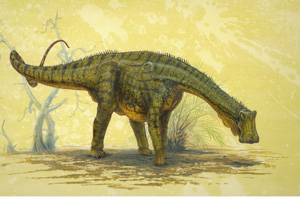Nigersaurus taqueti: Jaw bone found in Niger resembles no other sauropodís
By Steve KoppesNews Office
 Nigersaurus taqueti is shown in this drawing as it looked in the flesh. Paleontologist Paul Sereno’s research suggests the animal mowed down ferns and other plants with its lightweight skull and skeleton. Art by Todd Marshall, courtesy of Project Exploration, © 2007 National Geographic |
|
The weird jaw that paleontologist Paul Sereno’s team found in Niger perplexed him at first.
“I was disowning this bone,” said Sereno, Professor in Organismal Biology & Anatomy and National Geographic Explorer-in-Residence. He initially dismissed the possibility that it came from a dinosaur. Wondering if the jaw might belong to a coelacanth, a modern fish with an ancient lineage, he showed it to one of his colleagues for a second opinion. “I was struggling to find some other animal that it could belong to,” Sereno said.
Upon further cleaning, he flipped it around and it all began to make sense. The jaw belonged to a bizarre dinosaur, one he named Nigersaurus taqueti. CT scans would eventually expose its battery of more than 500 needle-like teeth. Its broad, square muzzle made it exquisitely adapted for eating plants low to the ground.
“It’s the dinosaurian equivalent of a cow,” Sereno said.
Nigersaurus is a distant relative of Diplocodus, its older, more famous North American cousin. Relatively small and short-necked for a sauropod, Nigersaurus measured 30 feet long and weighed about as much as an elephant. And strikingly, many of the bones in its skull are paper-thin.
“You wonder how it could do what it was doing. It’s breaking all the rules of what you would normally need to operate with a tooth battery.”
A CT scan of the jawbones revealed more than 50 columns of teeth. Each column contained as many as eight replacements to fill in when the front line wore out. Sereno estimates that Nigersaurus was wearing and replacing one tooth per month —twice as fast as any known dinosaur.
Nigersaurus probably munched ferns and horsetails during the Cretaceous Period 110 million years ago. Grass had yet to appear in Earth’s garden of botanical delights.
Sereno and five co-authors published details of the dinosaur’s anatomy and lifestyle in the online journal Public Library of Science ONE. Among the co-authors was Lawrence Witmer, Professor of Anatomy at Ohio University. Witmer took CT scans of the dinosaur’s brain and the organ that regulated its equilibrium. “What we have here is the first good look at a sauropod brain, and it has important things to say about this animal’s posture and behavior,” Witmer said.
 An expedition team member works to unearth some of the bones of Nigersaurus, a sauropod that walked the region 110 million years earlier. Nigersaurus lived in what is now the southern Sahara, in a habitat that also fostered the enormous crocodilian known as SuperCroc. Photo by Mike Hettwer, courtesy of Project Exploration,© 2007 National Geographic |
|
The CT scans showing the orientation of the organ of equilibrium led Sereno’s team to take a new look at the feeding habits of at least some sauropods. The snout of Nigersaurus would have normally pointed down, according to the orientation of the horizontal semicircular canals, just as one would expect of an animal foraging along the ground.
Unusual wear patterns on the outside of the dinosaur’s teeth also pointed to ground-level feeding. “We have giraffes on the brain when we see a long neck, because that’s what we live with,” Sereno said.
Early paleontologists posed sauropods browsing high in the trees because the first two ever discovered, Diplodocus and Apatosaurus, had very long necks. “They were the Sinclair dinosaurs that everybody comes to know and love,” he said.
Sereno and other expedition team members unveiled the bizarre anatomy of Nigersaurus at a Thursday, Nov. 15 news conference at National Geographic Society headquarters in Washington, D.C. Also on hand to witness the event was a special Nigersaurus delegation that included 10 Chicago-area high school students and three teachers. Project Exploration, a non-profit science education organization co-founded by Sereno and his wife, educator Gabrielle Lyon (B.A.’94, M.A.’94), organized the delegation.
“Participating in science in the making and meeting real scientists is key to getting students interested in science and to keeping them interested in science,” Lyon said.
![[Chronicle]](/images/sidebar_header_oct06.gif)